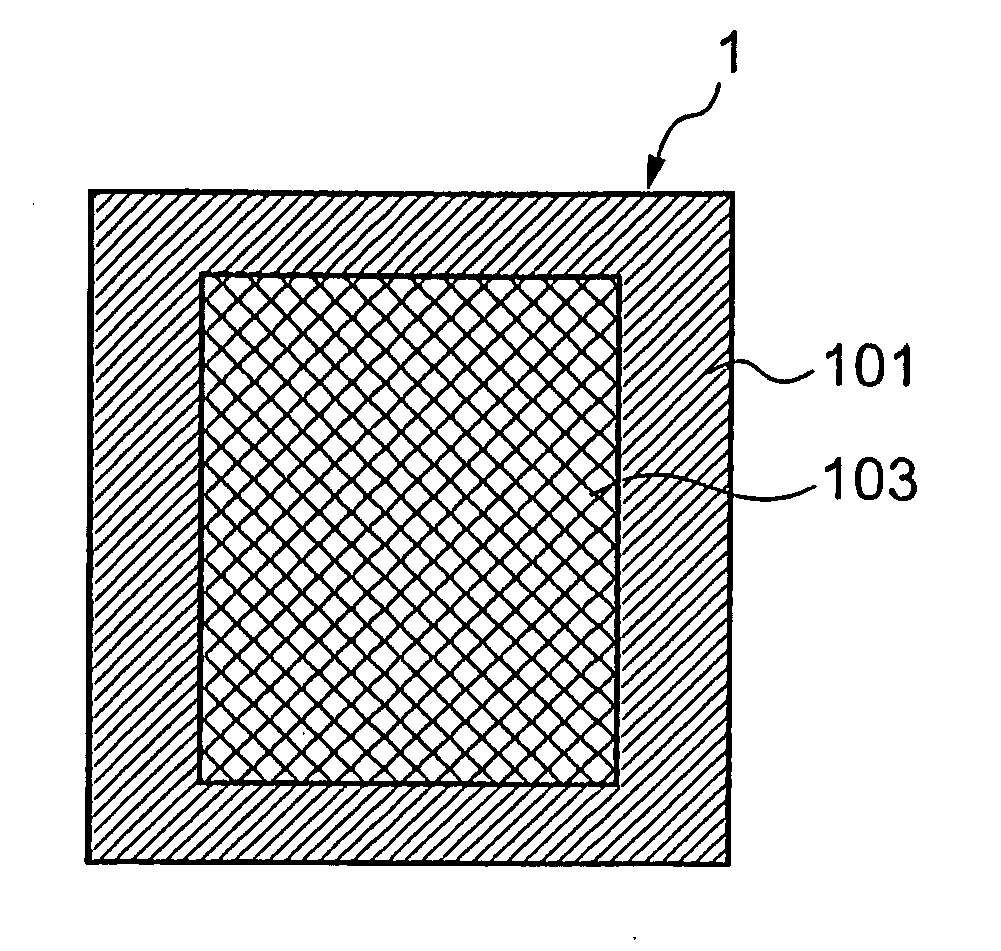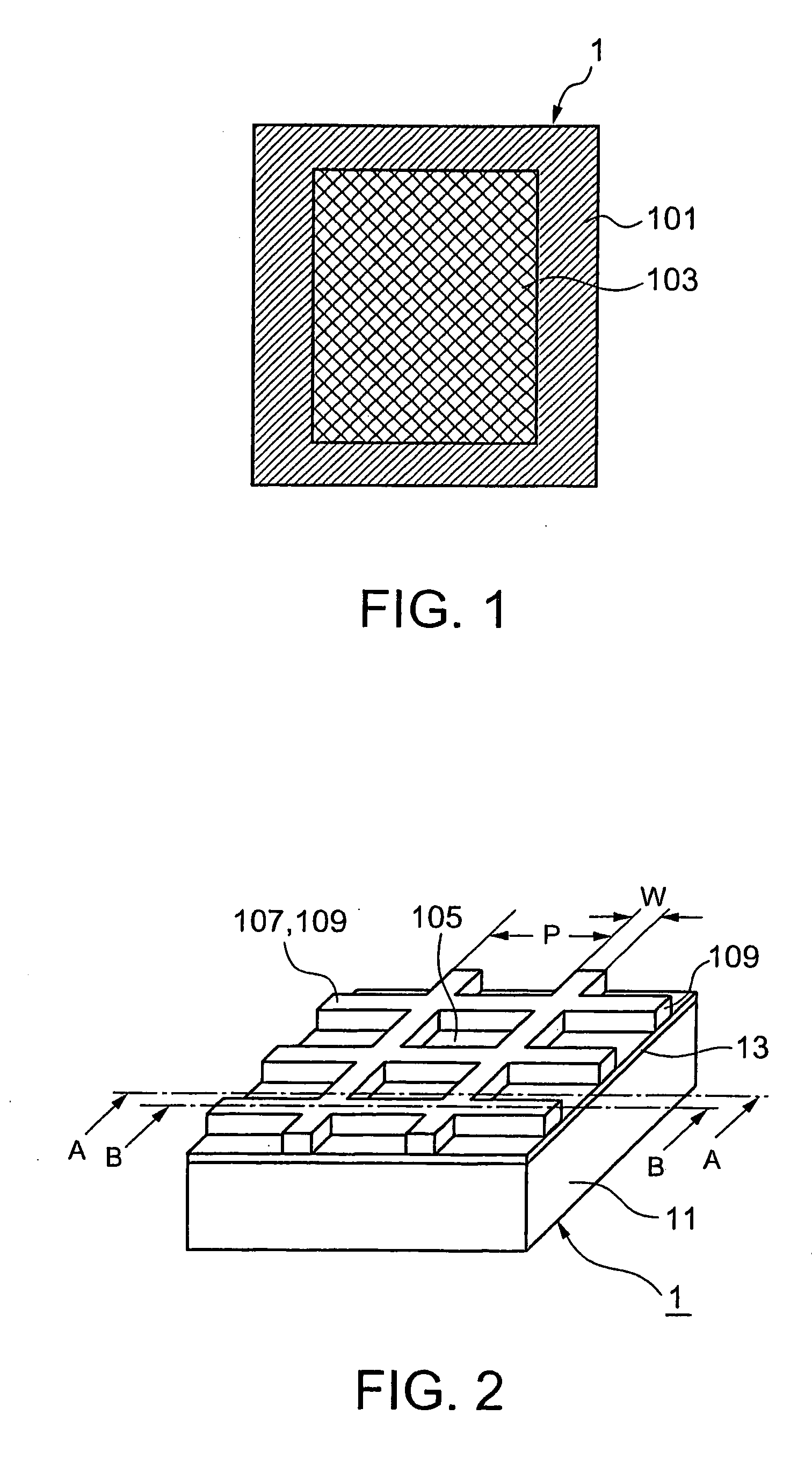Electromagnetic shielding sheet and method for manufacturing same
a technology of electromagnetic shielding and thin film, applied in the field of electromagnetic shielding sheet, can solve the problems of difficult formation of fine lines, difficulty in reducing the fineness of fine lines to increase transmittance, excessive surface electrical resistance of conductive thin film, etc., and achieves a high yield rate and continuous and efficient
- Summary
- Abstract
- Description
- Claims
- Application Information
AI Technical Summary
Benefits of technology
Problems solved by technology
Method used
Image
Examples
example 1
[0140] A conductive structure was formed by subjecting a 10 μm thick electrolytic Cu foil, which serves as a metal layer 21, to a cathodic electrodeposition process to form blackened layers 23A and 23B consisting of Cu—Co alloy particles having a mean particle size of 0.3 μm on the Cu foil, and a chromating treatment to form density-intensifying layers on the blackened layers 23A and 23B. A 100 μm thick transparent, biaxially oriented PET film A4300® (Toyobo) as a base was laminated to the surface treated by the chromating treatment of the Cu foil with a two-part polyurethane adhesive. A structure formed by laminating the PET film and the Cu foil was aged at 50° C. for three days. The two-part adhesive includes TAKERAKKU A-310® (polyol) (Takeda Yakuhin Kogyo) as an adhesive resin, and Hardener A-10® (isocyanate) (Takeda Yakuhin Kogyo) as a hardener. The two-part adhesive was spread in a 4 μm thick film in a dry state.
[0141] The structure formed in a continuous laminated film was ma...
example 2
[0150] Electromagnetic shielding sheets in Example 2 were fabricated by the steps of coating the surfaces of the mesh structures of the electromagnetic shielding sheets in Example 1 with a film of a flattening composition, laminating a 50 μm thick SP-PET20-BU® (Tosero), i.e., a PET film having a surface having a release characteristic, to the surface of the film of the flattening composition, exposing the thus coated electromagnetic shielding sheets to radiation of an intensity of 200 mj / cm2 (in terms of 365 nm) emitted by a high-pressure mercury lamp, and removing the SP-PET20-BU. The electromagnetic shielding sheets in Example 2 had abilities similar to those of the electromagnetic shielding sheets in Example 1.
[0151] The flattening composition was prepared by mixing 20 parts by mass of N-vinyl-2-pyrrolidone, 25 parts by mass dicyclopentenyl acrylate, 52 parts by mass oligoester acrylate (M-8060®, To a Gosei), and 3 parts by mass 1-hydroxycyclohexyl phenylketone (IRUGACURE 184, c...
example 3
[0152] Electromagnetic shielding sheets in Example 3 were fabricated similarly to those in Example 2, except that the electromagnetic shielding sheets in Example 3 had a flattening layer formed of a material prepared by adding one part by mass thiol-nickel complex, i.e., a near-infrared absorbing agent. The electromagnetic shielding sheets in Example 3 had abilities similar to those of the electromagnetic shielding sheets in Example 1, and an effect on improving the visibility of displayed images higher than that of Example 1.
PUM
| Property | Measurement | Unit |
|---|---|---|
| wavelengths | aaaaa | aaaaa |
| wavelengths | aaaaa | aaaaa |
| wavelengths | aaaaa | aaaaa |
Abstract
Description
Claims
Application Information
 Login to View More
Login to View More - R&D
- Intellectual Property
- Life Sciences
- Materials
- Tech Scout
- Unparalleled Data Quality
- Higher Quality Content
- 60% Fewer Hallucinations
Browse by: Latest US Patents, China's latest patents, Technical Efficacy Thesaurus, Application Domain, Technology Topic, Popular Technical Reports.
© 2025 PatSnap. All rights reserved.Legal|Privacy policy|Modern Slavery Act Transparency Statement|Sitemap|About US| Contact US: help@patsnap.com



